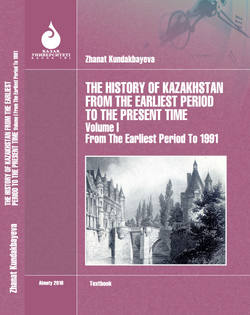The History of Kazakhstan from the Earliest Period to the Present time. Volume I

Реклама. ООО «ЛитРес», ИНН: 7719571260.
Оглавление
Zhanat Kundakbayeva. The History of Kazakhstan from the Earliest Period to the Present time. Volume I
INTRODUCTION
І Part. KAZAKHSTAN LANDS INHABITANTS IN EARLIEST PERIOD
1.1 The Stone Age archeological sites on the territory of Kazakhstan
1.2 The Bronze Age Archeological Sites on the Present-Day Kazakhstan territory
1.3 The Iron Age on the Kazakhstan territory
1.3.1 The Saka tribes on the Kazakhstan territory: sources evidences
1.3.2. Emergence and evolution of nomadic pastoralism in Eurasian Steppe
IІ Part. KAZAKHSTAN LANDS IN THE STRUCTURE OF THE TURKIC KHAGANATES (VI-XII CC.)
2.1 The political history of the First Turk khaganate (551-630)
2.2 Kazakhstan lands under the Western Turk khagans and its successors’ power
2.3 Cultural heritage of the Turks
2.3.1. Religions and beliefs of ancient Turks
2.3.2 Ancient Turks written monuments
IIІ Part. KAZAKHSTAN IN THE STRUCTURE OF THE MONGOLIAN STATES (XIII-XV CC.) AND POST-MONGOLIAN STATE UNIONS (XIV-XV CC.)
3.1 Central Asia before the Mongolian invasion
3.2 Kazakhstan in the structure of the ulus Juji and Golden Horde (the XIII – the first half of the XV centuries)
3.3 South and South-Eastern Kazakhstan in the structure of the Chagatai Khanate (XIII-XV cc.)
3.4 Post-Mongolian State unions on the territory of Kazakhstan
3.4.1 Ak-Horde – the first state entity on the local ethnic basis on the territory of Kazakhstan
3.4.2 Eastern Desht-i-Kipchak in the structure of the Nomadic Uzbek State (Abulkhair Khanate) 1428-1468
3.4.3. Western Kazakhstan in the structure of the Nogay Horde
3.4.4 South-East Kazakhstan in the structure of the Moghulistan
ІV Part. KAZAKH KHANATE AND FORMATION OF KAZAKH NATION EPOCH, THE MIDDLE OF THE XV – THE FIRST THIRD OF THE XVIII CENTURIES
4.1 Written sources on the Kazakh Khanate (the second half of the XV- the first third of XVIII centuries)
4.2 Formation and strengthening of the Kazakh khanate 1470-1500
4.3 Historiography of the problem «Formation of the Kazakh Nation»
4.4 The Kazakh khanate in the first half of the XVI century
4.5 Internal and external position of the Kazakh Khanate in the second half of the XVI – XVII cc
4.6 Material and spiritual culture of Kazakh people in XVI-XVII centuries
V Part. KAZAKHSTAN LANDS IN THE STRUCTURE OF THE RUSSIAN EMPIRE, 1731-1917
5.1 Different approaches to the study of the nature, objectives and policies techniques of the Russian Empire in relation to the national borderlands
5.2 The process of Kazakh Zhuses integration to Russian Empire, 1731-1865
VІ Part. KAZAKHSTAN IN THE STRUCTURE OF THE SOVIET UNION, 1917-1991
6.1 Kazakhstan in the pre-war time, 1917-1939
6.1.1 Building the Soviet model of the Nation and State structure in Kazakhstan
6.1.2 Soviet modernization of economic relations in Kazakhstan Modernization/Industralization in Kazakhstan
6.1.3 Implementation of soviet cultural modernization project in Kazakhstan, 1920-1930
6.2 Kazakhstan during the Great Patriotic War, 1941-1945 and Post-War period, 1946-1953
6.2.1 Memory about the Great Patriotic War, 1941-1945 in the Contemporary post-Soviet states
6.2.2 The Soviet Massive Deportations to Kazakhstan
6.2.3 Kazakhstan in the post-war period, 1946-1953
6.3 Kazakhstan in the period of Khrushchev’s reforms, 1953-1964
6.3.1 The development of virgin and fallow lands in Kazakhstan: Achievements and Challenges
6.3.2 The public life in Kazakhstan during Khrushchev’s reforms
6.4 Kazakhstan in the Brezhnev era, 1964-1982
6.5 Kazakhstan in the Gorbachev era, 1964-1982104
Appendix I
Appendix II
Отрывок из книги
The beginning of human history has been reconstructed entirely through archaeological material– artefacts of daily use, tools and weapons, pots and pans, toys and playthings, dress and ornaments, furniture and fabrications of all sorts, objects of and for worship as well as many other items that constitute human culture or cultures. So, archeological sources are very important for reconstructing the periods when the written sources did not emerge Archeologists use their own periodization. The names for archaeological periods in the list of archaeological periods vary enormously from region to region. Dating also varies considerably across wide areas. The three-age system has been used in many areas, referring to the prehistorical periods identified by tool manufacture and use, of the Stone Age, the Bronze Age and the Iron Age. Since these ages are distinguished by the development of technology, it is natural that the dates, to which these refer, vary in different parts of the world. So, according to this periodization system the Stone Age is divided into the Paleolithic era, the Mesolithic era and the Neolithic Era. As Jeremy Tredinnick mentioned, Kazakhstan’s role in the history of mankind is significant, if to look at the history of settling the earth by first humans. Jeremy Tredinnick emphasizes that although there are many theories about when, in what way and where the first humans moved out of Africa, there is solid archaeological evidence that the ancestors (Homo habilis, Homo Erectus, Homo Neanderthalensis and Homo Sapiens) migrated from the Middle East to Central Asia and stayed here. According to Jeremy Tredinnick: "Modern-day genome Controling has subsequently shown that the colonization by humans of both northern Europe and Siberia- and from there North America – began in Central Asia and of territory of Kazakhstan."1
When the first hominids had settled on the coast of the Caspian Sea and the ridges of Karatau, Central Asia was a hot, humid savanna under the influence of a monsoonal climate from the south. Therefore, the first people settled near water sources. As soon as the tectonic movements in the Tien Shan resulted in the state of Mountains, the climate had changed. In the conditions of changes in the monsoons and cyclones, increasing continental climate in the arid zone, a considerable part of the Kazakhstan territory was desertificated.
.....
Task for independent study:
Write 500 words essay on the topic: "The significance of the Ancient Turkic culture in the World history".
.....